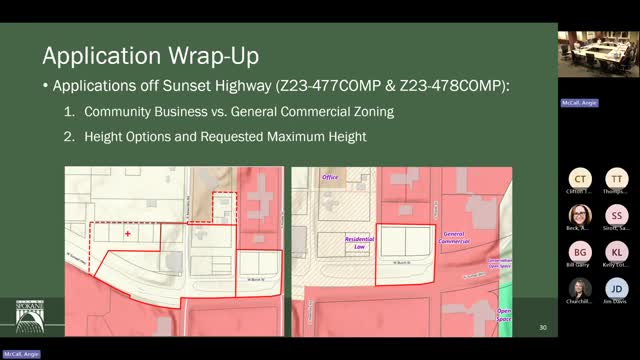Height and zoning options spark heated community debate
July 29, 2024 | Spokane, Spokane County, Washington

This article was created by AI summarizing key points discussed. AI makes mistakes, so for full details and context, please refer to the video of the full meeting. Please report any errors so we can fix them. Report an error »

In a recent government meeting, officials discussed zoning classifications and height regulations for commercial developments, focusing on two primary zones: General Commercial and Community Business. The General Commercial zone allows for a wider range of retail and service businesses, accommodating multifamily developments, while the Community Business zone is designed to limit commercial size and impact, particularly in residential areas.
The meeting highlighted the differences in permitted uses and conditional use permits (CUP) between the two zones. General Commercial permits larger developments, requiring a CUP only for projects exceeding 70,000 square feet, while Community Business has a lower threshold of 50,000 square feet. Additionally, the floor area ratio is more generous in General Commercial (2.5) compared to Community Business (1.5), allowing for taller buildings in the former, with a default height of 70 feet versus 55 feet in the latter.
Both applicants for new developments expressed preferences for the General Commercial designation, particularly for its height allowances. The discussion also touched on the process for adjusting height limits, noting that applicants could request height modifications administratively without undergoing a full comprehensive plan amendment, making it a more streamlined process.
The meeting concluded with officials clarifying that while the default height options are 35, 40, 55, 70, or 150 feet, recent changes could allow for a maximum height of 75 feet if new regulations are adopted. This flexibility is seen as beneficial for future developments, allowing for adjustments based on evolving plans and site-specific considerations.
The meeting highlighted the differences in permitted uses and conditional use permits (CUP) between the two zones. General Commercial permits larger developments, requiring a CUP only for projects exceeding 70,000 square feet, while Community Business has a lower threshold of 50,000 square feet. Additionally, the floor area ratio is more generous in General Commercial (2.5) compared to Community Business (1.5), allowing for taller buildings in the former, with a default height of 70 feet versus 55 feet in the latter.
Both applicants for new developments expressed preferences for the General Commercial designation, particularly for its height allowances. The discussion also touched on the process for adjusting height limits, noting that applicants could request height modifications administratively without undergoing a full comprehensive plan amendment, making it a more streamlined process.
The meeting concluded with officials clarifying that while the default height options are 35, 40, 55, 70, or 150 feet, recent changes could allow for a maximum height of 75 feet if new regulations are adopted. This flexibility is seen as beneficial for future developments, allowing for adjustments based on evolving plans and site-specific considerations.
View full meeting
This article is based on a recent meeting—watch the full video and explore the complete transcript for deeper insights into the discussion.
View full meeting
